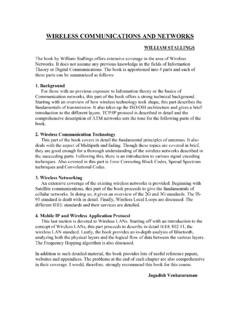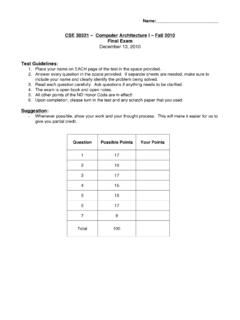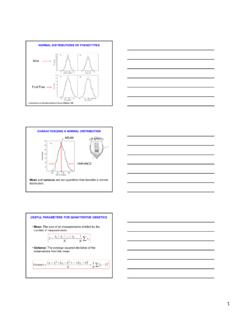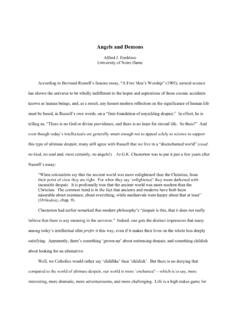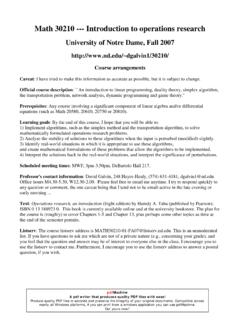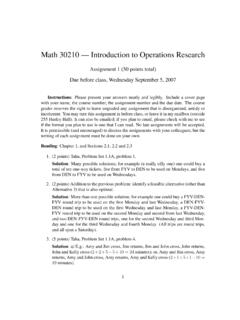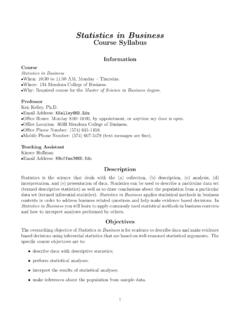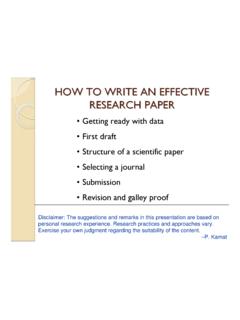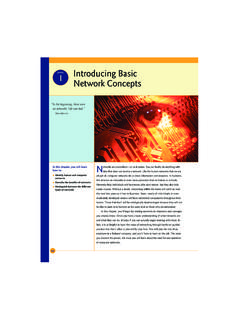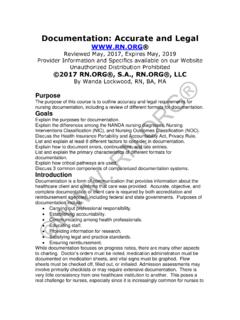Transcription of Common DCF Errors (LMIS) - University of Notre Dame
1 LEGG MASON. CAPITAL MANAGEMENT. March 16, 2006. Michael J. Mauboussin Common Errors in DCF Models Do You Use Economically Sound and Transparent Models? Discounted cash flow analysis is the most accurate and flexible method for valuing projects, divisions, and companies. Any analysis, however, is only as accurate as the forecasts it relies on. Errors in estimating the key ingredients of corporate value .. can lead to mistakes in valuation. Tim Koller, Marc Goedhart, and David Wessels Valuation: Measuring and Managing the Value of Companies 1. A Return to First Principles Say you had to come up with a fair offer to buy your local dry cleaner and the seller limited the extent of your financial information to the answers to five questions.
2 Which questions would you ask? Chances are you wouldn't ask how the quarter is progressing or about last year's earnings, but you would focus on the prospects for cash coming in versus cash going out over time. Sole proprietors understand intimately that the value of their business hinges on the cash flow the business generates. No distributable cash, no value. Cash puts food on the table and pays the mortgage; earnings do not. Equity investors are business buyers. While most shareholders own only a small fraction of a company, they are owners nonetheless. The source of shareholder value, and value changes, is no different than the sole proprietor's: it's all about the cash.
3 Most investors don't think this way. In part, this is because market exchanges readily allow investors to trade cash today for claims on future cash flows, and vice versa, encouraging them to forget they are evaluating, buying, and selling businesses. Yet investors, as opposed to speculators, should never lose sight of their objective: buying a stream of cash flows for less than what it is worth. Given that cash inflows and outflows are the lifeblood of corporate value, you might expect investors to be intent on measuring and valuing cash flows. Indeed, valuation in the bond and commercial real estate markets is all about cash.
4 In practice, however, very few equity investors dwell on cash. Proxies for value, like earnings and multiples, dominate Wall Street valuation work. Because markets are mostly efficient, investors can get away with using value proxies without awareness of what the proxies actually represent. The result is complacency and a false sense of understanding. As a consequence most investors don't do fundamental valuation work; when they do, they often do the work incorrectly. First principles tell us the right way to value a business is to estimate the present value of the future cash flows. While most Wall Street professionals learned about discounted cash flow (DCF) models in school, in practice the models they build and rely on are deeply flawed.
5 Not surprisingly, the confidence level in these DCF models is very low. This faint confidence is not an indictment of analytical approach but rather of analytical methods. DCF models should be economically sound and transparent. Economically sound means the company's return and growth patterns are consistent with the company's positioning and the ample empirical record supporting reversion to the mean. Transparent means you understand the economic implications of the method and assumptions you choose. Most DCF models fail to meet the standards of economic soundness and transparency. The List Here's our list of the most frequent Errors we see in DCF models.
6 We recommend you check your models, or the models you see, versus this list. If one or more of the Errors appear, the model will do little to inform your business judgment. 1. Forecast horizon that is too short. One of the most Common criticisms of DCF models is that any forecast beyond a couple of years is suspect. Investors, therefore, are alleged to be better off using more certain, near-term earnings forecasts. Such reasoning makes no sense, for at least two reasons. First, a key element in understanding a business's attractiveness involves knowing the set of financial expectations the price represents.
7 The market as a whole has historically traded at a price-to-earnings multiple in the mid-to-high teens. Simple math shows today's stock prices reflect expectations for value-creating earnings and cash flows many years in the future. To make the point more concrete, imagine you are a restaurant industry executive in charge of finding new store locations. When assessing the attractiveness of a prospective site, would you consider only two years of earnings because any beyond that is guessing ? Of course not. You'd base your judgment on the location, past results for similar sites, and other value-relevant factors.
8 Intelligent capital allocators take a long-term view. The mismatch between a short forecast horizon and asset prices that reflect long-term cash flows leads to the second problem: investors have to compensate for the undersized horizon by adding value elsewhere in the model. The prime candidate for the value dump is the continuing, or terminal, value. The result is often a completely non-economic continuing value. This value misallocation leaves both parts of the model the forecast period and continuing value estimate next to useless. Some investors swear off the DCF model because of its myriad assumptions.
9 Yet they readily embrace an approach that packs all of those same assumptions, without any transparency, into a single number: the multiple. 3 Multiples are not valuation; they represent shorthand for the valuation process. Like most forms of shorthand, multiples come with blind spots and biases that few investors take the time and care to understand. John Maynard Keynes famously said, I'd rather be vaguely right than precisely wrong. His message applies here. We recommend explicit forecast periods of no less than five years, and note many companies require over ten years of value-creating cash flows to justify their stock prices.
10 Ideally, the explicit forecast period should capture at least one-third of corporate value with clear assumptions about projected financial performance. While the range of possible outcomes certainly widens with time, we have better analytical tools to deal with an ambiguous future than to place an uncertain multiple on a more certain near-term earnings per share figure. We address the uncertainty issue below. Page 2. Legg Mason Capital Management 2. Uneconomic continuing value. The continuing value component of a DCF model captures the firm's value for the time beyond the explicit forecast period, which can theoretically extend into perpetuity.
